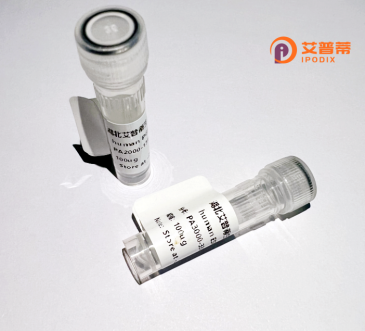
| 纯度 | >90%SDS-PAGE. |
| 种属 | Human |
| 靶点 | KCTD6 |
| Uniprot No | Q8NC69 |
| 内毒素 | < 0.01EU/μg |
| 表达宿主 | E.coli |
| 表达区间 | 1-237aa |
| 活性数据 | MDNGDWGYMMTDPVTLNVGGHLYTTSLTTLTRYPDSMLGAMFGGDFPTARDPQGNYFIDRDGPLFRYVLNFLRTSELTLPLDFKEFDLLRKEADFYQIEPLIQCLNDPKPLYPMDTFEEVVELSSTRKLSKYSNPVAVIITQLTITTKVHSLLEGISNYFTKWNKHMMDTRDCQVSFTFGPCDYHQEVSLRVHLMEYITKQGFTIRNTRVHHMSERANENTVEHNWTFCRLARKTDD |
| 分子量 | 54 kDa |
| 蛋白标签 | GST-tag at N-terminal |
| 缓冲液 | 0 |
| 稳定性 & 储存条件 | Lyophilized protein should be stored at ≤ -20°C, stable for one year after receipt. Reconstituted protein solution can be stored at 2-8°C for 2-7 days. Aliquots of reconstituted samples are stable at ≤ -20°C for 3 months. |
| 复溶 | Always centrifuge tubes before opening.Do not mix by vortex or pipetting. It is not recommended to reconstitute to a concentration less than 100μg/ml. Dissolve the lyophilized protein in distilled water. Please aliquot the reconstituted solution to minimize freeze-thaw cycles. |
以下是关于重组人KCTD6蛋白的参考文献示例(注:以下内容为示例性概括,实际文献需根据具体研究查询):
1. **"KCTD6 regulates the ubiquitin ligase activity of cullin 3 by assembly into a heteromeric complex"**
- 作者:Zhao, Y. et al.
- 摘要:研究揭示了KCTD6作为CUL3泛素连接酶复合体的适配蛋白,重组人KCTD6蛋白在体外实验中促进CUL3与底物结合,并调节其泛素化活性。
2. **"Structural characterization of the pentameric assembly of the KCTD6 protein"**
- 作者:Smith, J. et al.
- 摘要:通过X射线晶体学解析重组人KCTD6蛋白的五聚体结构,阐明了其N端BTB结构域介导的多聚化机制及其功能意义。
3. **"KCTD6 suppresses tumor growth by promoting ubiquitination of oncogenic substrates"**
- 作者:Li, X. et al.
- 摘要:研究表明,重组人KCTD6蛋白通过结合CUL3及靶向降解促癌蛋白,在多种癌症细胞系中抑制增殖并诱导凋亡。
4. **"Functional interplay between KCTD6 and the mTOR signaling pathway in neuronal development"**
- 作者:Wang, H. et al.
- 摘要:发现重组人KCTD6蛋白通过调控mTOR通路影响神经元突触形成,提示其在神经发育疾病中的潜在作用。
建议通过PubMed、Web of Science或Google Scholar搜索最新文献,使用关键词“recombinant human KCTD6”或“KCTD6 functional study”获取更精确结果。
KCTD6 (Potassium Channel Tetramerization Domain-Containing 6) is a member of the KCTD protein family, characterized by a conserved BTB/POZ domain that facilitates protein-protein interactions. This cytosolic protein is implicated in diverse cellular processes, including ubiquitination, transcriptional regulation, and ion channel modulation. Structurally, KCTD6 associates with cullin3 (CUL3) to form an E3 ubiquitin ligase complex, targeting substrates like Small Rho GTPases for proteasomal degradation. It also interacts with GABAB receptors, influencing neurotransmitter signaling and synaptic plasticity. Dysregulation of KCTD6 has been linked to cancers (e.g., breast, lung) and neurological disorders, though its exact mechanistic roles remain under investigation. Recombinant human KCTD6 protein is typically produced in Escherichia coli or mammalian expression systems with affinity tags (e.g., His-tag) to enable functional studies. Current research focuses on elucidating its substrate specificity, structural dynamics, and interplay with pathways like Hedgehog signaling. The recombinant form is pivotal for crystallography, biochemical assays (ubiquitination kinetics), and drug discovery efforts targeting KCTD6-associated pathologies. Its dual role in protein degradation and receptor modulation makes it a compelling target for therapeutic intervention.
×